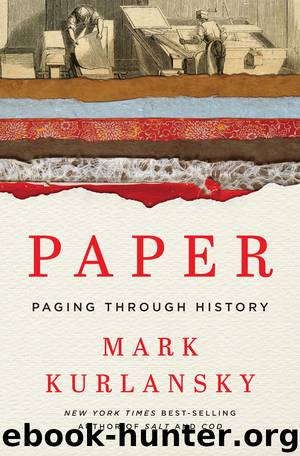Paper : Paging Through History (9780393285482) by Kurlansky Mark

Author:Kurlansky, Mark [Kurlansky, Mark]
Language: eng
Format: epub
Publisher: W W Norton & Co Inc
Published: 2016-05-14T23:00:00+00:00
____________
IN EIGHTEENTH-CENTURY ENGLAND, papermakers and artists started working together to develop new papers for new art forms. In 1740, England’s most celebrated papermaker, James Whatman, started Turkey Mill, where among the innovations for artists was “wove paper.”
The traditional papermaking mold had horizontal wires braided into the vertical wires every inch or so, which left a ribbed pattern on paper—this was called laid paper. Whatman thought that some art and possibly some printing might look better on paper without this pattern. So in 1754 he bought brass wire cloth, a newly manufactured product, and experimented with this fine mesh, to produce the first wove paper—smooth paper with no mold marks—in 1759.
Wove paper immediately came to the attention of John Baskerville, a leading printer whose work was so admired by Benjamin Franklin that he adopted his type for the first printing done by the US government. Baskerville printed his 1755 edition of Virgil on wove paper. Papermakers began to think that with their new, smooth paper, they could at last dethrone parchment from its perch in the luxury market. Wove paper was sometimes called vellum paper or wove vellum because it was considered to be as fine and smooth as vellum. When the French started producing wove paper in the late 1770s, they too called it papier vélin, vellum paper.
Soon the British began to produce a thicker, hand-sized wove paper that came to be called drawing paper. It was actually designed not so much for drawing as for watercolors. Just enough sizing was used to allow paint to remain on the surface and dry brilliantly before sinking into the paper. The paper was also thick enough for techniques such as scraping, rubbing, and wiping—to remove excess paint—to be used without wearing a hole in the paper.
Watercolors, beloved in East Asia for centuries, had never been regarded as a serious art form in the West before. But suddenly there was a growing public embrace of all forms of paper art, and though the times were not easy—Britain was at war with France for more than twenty years in the late 1700s—there was an expanding market for it in England. With England cut off from French imports because of the war, British papermakers also had an unexpected opportunity. Previously, France had been Britain’s source of art paper; but the native papermakers could now fill the void.
Stationers and other shops that sold etchings, watercolors, papier-mâché objects, paper, and books conducted a brisk business, especially in London. They also became social meeting places, part of the intellectual life that Benjamin Franklin had so loved about London.
One of the most popular stationers was Ackermann’s Repository of Arts. Rudolph Ackermann was a German who had moved to London, where he published books. His first was a book on watercolors, and he gave lessons in the popular new art form in his store. He sold paper and art and his own brand of watercolor in dried, compressed cakes—a new invention from another London art supply company, Thomas Reeves. In 1813 Ackermann added a tearoom and a library.
Download
This site does not store any files on its server. We only index and link to content provided by other sites. Please contact the content providers to delete copyright contents if any and email us, we'll remove relevant links or contents immediately.
| Anthropology | Archaeology |
| Philosophy | Politics & Government |
| Social Sciences | Sociology |
| Women's Studies |
Cecilia; Or, Memoirs of an Heiress — Volume 1 by Fanny Burney(32022)
Cecilia; Or, Memoirs of an Heiress — Volume 3 by Fanny Burney(31436)
Cecilia; Or, Memoirs of an Heiress — Volume 2 by Fanny Burney(31380)
The Great Music City by Andrea Baker(30641)
We're Going to Need More Wine by Gabrielle Union(18605)
All the Missing Girls by Megan Miranda(14588)
Pimp by Iceberg Slim(13717)
Bombshells: Glamour Girls of a Lifetime by Sullivan Steve(13665)
Fifty Shades Freed by E L James(12886)
Talking to Strangers by Malcolm Gladwell(12813)
Norse Mythology by Gaiman Neil(12782)
For the Love of Europe by Rick Steves(11331)
Crazy Rich Asians by Kevin Kwan(8860)
Mindhunter: Inside the FBI's Elite Serial Crime Unit by John E. Douglas & Mark Olshaker(8663)
The Lost Art of Listening by Michael P. Nichols(7125)
Enlightenment Now: The Case for Reason, Science, Humanism, and Progress by Steven Pinker(6852)
The Four Agreements by Don Miguel Ruiz(6284)
Bad Blood by John Carreyrou(6252)
Weapons of Math Destruction by Cathy O'Neil(5800)
